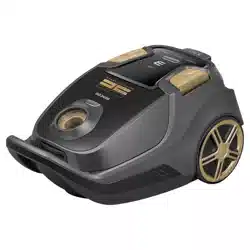Loading ...
Loading ...
Loading ...

05/2019
- 8 -
Copyright © 2019, Fast ČR, a.s.
STORING ACCESSORIES
■ The vacuum cleaner is equipped with ahandy accessory storage compartment. Press
button A5 to release the accessory compartment cover A6. Here you can place the
dusting brush A28 and the crevice nozzle A29.
CLEANING AND MAINTENANCE
■ Disconnect the power plug from the power socket before cleaning.
Warning:
To prevent the risk of injury by electrical shock, do not submerge
theappliance, power cord or power plug in water or any another
liquid.
Changing the dust bag
■ When the indicator is lit red, it indicates the need to replace the dust bag or aclogged
suction hole. In the event that the suction hole becomes clogged, remove the items
that are clogging it. To replace the dust bag, proceed as follows.
■ Press button A3 to tilt open the dust bag compartment A20. Remove the used dust
bag from the holder A19 and insert anew bag of the same type. Then close the cover
A3. The vacuum cleaner is equipped with asafety mechanism that prevents the cover
A3 from being closed unless the bag is correctly inserted or when it is not inserted
at all.
■ If the dust bag is not replaced in time, the vacuum cleaner’ssuction power will be
reduced.
Note:
Sometimes, while vacuuming, the indicator may briefly be lit red, which
does not indicate afull dust bag, but rather that suction power is set
too high for the given type of vacuumed surface. In such acase, reduce
the suction power.
Cleaning and replacing the inflow and outflow filters
■ Press button A3 to tilt open the dust bag compartment A20. Take out the dust bag
A20. Remove the protective grille of the inflow filter A18. Take out the inflow filter
A17 and tap it out away from living areas. Then put it back in, insert the dust bag A20
and close the cover A3. In the event that the inflow filter A17 shows signs of wear, or
is heavily soiled, replace it with anew one.
■ In order to clean and replace the HEPA filter A15, which is located at the rear of the
vacuum cleaner, press the clips on the removable grille A16 and take it out. Then take
out the HEPA filter A15. Tap it out away from living areas. Wash the HEPA filter A15
under aweak current of running lukewarm water so that the water washes the dirt out
of the folds. Allow it to dry naturally. Then insert it back in its place. It is recommended
to replace the HEPA filter A15 with anew one after 6 months of use.
Attention:
Before putting the filters back into the vacuum cleaner, make
sure that they are completely dry.
When filters are soiled, their effectiveness is reduced, so do not
neglect their regularly cleaning.
Cleaning the accessories
■ If the accessories are soiled, remove them from the vacuum cleaner and clean all dirt
off of them (dust, hair, animal fur, etc.).
■ To make removing hair wound on to the rotary brush easier to remove, you may cut
this hair using scissors.
Cleaning the turbo brush
Release the latches along the sides of the turbo brush A23, see figure C1. Remove the
front cover and remove all dirt, hair, animal fur, etc. from the rotary brush and the inner
area. After cleaning, put the front cover back and secure it in place using the locking
latches.
Press the cover latches located on the underside of the turbo brush A23 to release them,
see figure C2. Remove the cover and remove any soils from the inner area of the turbo
brush A23. Put the cover back in its place. An audible click will be heard when it slides
back into place.
Cleaning the outer surface of the vacuum cleaner
Clean the outer surface using adry or alightly dampened cloth. Then wipe it thoroughly
dry.
For cleaning the vacuum cleaner, do not use steel wool, abrasive cleaning products,
solvents etc.
TECHNICAL SPECIFICATIONS
Rated voltage range ............................................................................................................. 220 – 240 V~
Rated frequency ........................................................................................................................... 50 / 60 Hz
Rated power input ............................................................................................................................. 600 W
Power source of remote control ........................................................ 2× 1.5 Vtype AAA batteries
Noise level ......................................................................................................................................... 59 dB(A)
The declared noise emission level of the appliance is 59 dB(A), which represents alevel
Aof acoustic power with respect to areference acoustic power of 1 pW.
Safety class for electrical shock protection:
Class II – Electrical shock protection is provided by double or heavy-duty
insulation.
We reserve the right to change text and technical specifications.
INSTRUCTIONS AND INFORMATION REGARDING THE DISPOSAL
OF USED PACKAGING MATERIALS
Dispose of used packaging material at asite designated for waste in your municipality.
DISPOSAL OF USED ELECTRICAL AND ELECTRONIC EQUIPMENT
This symbol on products or original documents means that used electric
or electronic products must not be added to ordinary municipal waste.
For proper disposal, renewal and recycling hand over these appliances
to determined collection points. Alternatively, in some European Union
states or other European countries you may return your appliances to
the local retailer when buying an equivalent new appliance.
Correct disposal of this product helps save valuable natural resources
and prevents potential negative effects on the environment and human
health, which could result from improper waste disposal. Ask your local authorities or
collection facility for more details.
In accordance with national regulations penalties may be imposed for the incorrect
disposal of this type of waste.
For business entities in European Union states
If you want to dispose of electric or electronic appliances, ask your retailer or supplier for
the necessary information.
Disposal in other countries outside the European Union.
This symbol is valid in the European Union. If you wish to dispose of this product, request
the necessary information about the correct disposal method from the local council or
from your retailer.
This product meets all the basic requirements of EU directives related to it.
